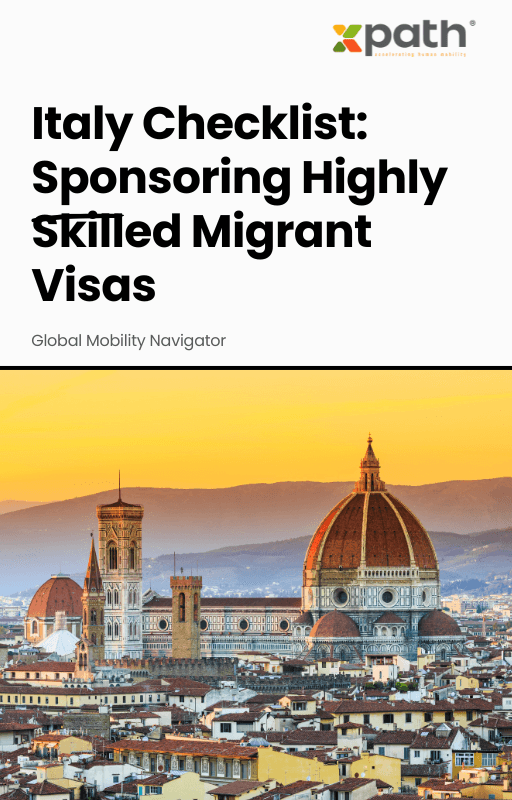Italy Checklist: Sponsoring Highly Skilled Migrant Visas
Grab a copy of a guide to international employee relocation
View E-bookEver wondered what truly holds a global workforce together? It’s not just relocation logistics or streamlined onboarding—it’s the ability to offer solid health coverage and seamless social security integration. Without these, even the best-laid international assignment plans can unravel fast.
The rise of cross-border assignments, remote teams, and international projects has made the need for robust global mobility solutions more pressing than ever. But a truly effective program isn’t just about moving people from point A to point B. Increasingly, companies are being judged by how well they safeguard employees’ health and financial security throughout their assignments.
Today, 80% of multinational organizations cite health coverage and pension integration as pivotal challenges in global mobility (Mercer, 2023). If your organization isn’t keeping pace, you risk higher attrition, compliance headaches, and diminished employee trust.
Picture this: you send a high-performing team member to Frankfurt. Within weeks, they fall ill and realize their health insurance doesn’t cover outpatient care—and local costs aren’t cheap. The stress mounts, productivity dips, and suddenly, the assignment no longer looks like a reward but a risk.
It’s not an isolated scenario. According to the 2022 Global Mobility Trends Survey by KPMG, 74% of expatriates rank health coverage as their top concern when accepting international assignments. Inadequate provision can result in failed assignments, costing companies an average of $75,000–$100,000 per case (Brookfield Global Relocation Services). In other words, overlooking health coverage is like forgetting the foundation when building a house. Everything may look fine—until the cracks start to show.
Social security integration is where even seasoned HR teams stumble. With each country boasting its own web of regulations on pensions, unemployment insurance, and employment taxes, navigating this maze is daunting. Failure to adequately address these integrations can expose companies and employees to double taxation, gaps in retirement savings, or outright legal penalties.
In fact, the International Organization for Migration reports that only 16% of international assignments successfully integrate social security, while 40% of repatriated employees report negative financial impacts from fragmented contributions. Clearly, this is more than a paperwork problem—it’s a matter of protecting an employee’s long-term welfare and trust.
Take the example of an international bank expanding operations in Asia and Europe. Historically, their mobility policy left employees juggling multiple local health plans and struggling to transfer social security benefits. Not surprisingly, assignment refusal rates hit 28%—well above industry norms.
Partnering with a global mobility platform like xpath.global, they centralized access to vetted international insurers, automated social security certificate tracking, and added transparent documentation for every host country. The result? Assignment refusals dropped to under 10%, and HR compliance costs fell by 22%. This isn’t just an operational win—it’s a strategic one, turning global mobility into a business accelerator rather than a bureaucratic headache.
The days of “one-size-fits-all” mobility programs are over. Here’s what’s shaping the landscape in 2024 and beyond:
First, more organizations are opting for global healthcare plans that travel seamlessly with employees. Allianz, Cigna, and Bupa all report double-digit growth in international employee health policies in recent years.
Second, technology platforms are revolutionizing social security management. Instead of manual forms and endless back-and-forth with authorities, integrated systems (like those pioneered by xpath.global) automate tracking, compliance, and reporting across multiple territories. By 2027, it’s expected that over 60% of Fortune 500 firms will have moved to digitized global mobility management platforms (Gartner, 2023).
Third, there’s growing awareness of the importance of mental health. Leading companies now include counseling and wellness support in their mobility packages, further reducing assignment failure rates and boosting employee wellbeing.
Despite advancements, the path isn’t always smooth. Firms grapple with complex host-country rules, frequent legislative changes, and varying expectations from their workforce. For many, the greatest challenges are:
Consistency: Ensuring every assignee, regardless of location, receives comparable health and social security coverage.
Compliance: Navigating a minefield of ever-evolving international insurance and pension regulations.
Transparency: Keeping employees informed about their benefits and obligations, especially when moving between vastly different healthcare systems.
Leveraging platforms like xpath.global enables HR teams to transform complexity into clarity, providing a single source of truth for all parties involved and drastically reducing compliance risks.
Managing health coverage and social security integration isn’t just a bureaucratic checkbox—it’s a make-or-break component of your global success. When these pillars are unstable, so too is your mobility program.
Instead, imagine a future where your mobility framework is secure, scalable, and effortlessly compliant. Employees are not just willing but eager to take on global roles—confident in the knowledge that their wellbeing and financial futures are protected.
Q: Can my employees maintain their home-country health insurance abroad?
A: In most cases, local laws or provider restrictions require international employees to switch—or supplement—with an international or host-country health plan.
Q: How are social security contributions managed during cross-border assignments?
A: Bilateral agreements, A1 or Certificate of Coverage forms, and centralized platforms like xpath.global can ensure compliance and avoid double payments.
Q: Is mental health support included in global mobility packages?
A: Increasingly, yes. Top employers now provide mental health resources alongside core health coverage for expatriates.
Q: What’s the risk of non-compliance with local health or social security laws?
A: Significant. Businesses risk fines, assignment failure, and employee dissatisfaction if these areas are mishandled.
Q: How can digital platforms help streamline health and social security integration?
A: They automate documentation, track eligibility, and provide clear, timely information to both HR and employees—dramatically reducing error rates and compliance costs.
Ready to transform your mobility program? Explore xpath.global’s solutions.

Italy Checklist: Sponsoring Highly Skilled Migrant Visas
Grab a copy of a guide to international employee relocation
View E-book